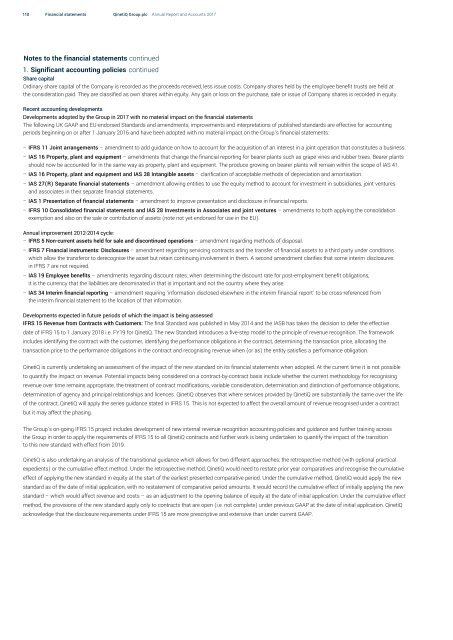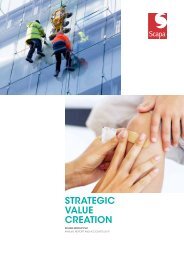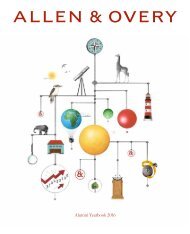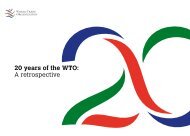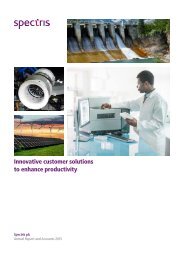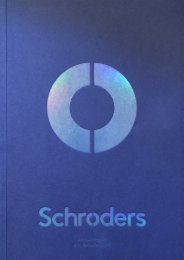QinetiQ Annual Report 2017
You also want an ePaper? Increase the reach of your titles
YUMPU automatically turns print PDFs into web optimized ePapers that Google loves.
110<br />
110<br />
Financial<br />
Financial statements<br />
statements <strong>QinetiQ</strong><br />
<strong>QinetiQ</strong> Group<br />
Group<br />
plc<br />
plc<br />
<strong>Annual</strong><br />
<strong>Annual</strong><br />
<strong>Report</strong><br />
<strong>Report</strong><br />
and<br />
and<br />
Accounts<br />
Accounts<br />
<strong>2017</strong><br />
<strong>2017</strong><br />
www.qinetiq.com<br />
Notes to the financial statements continued<br />
1. Significant accounting policies continued<br />
Share capital<br />
Ordinary share capital of the Company is recorded as the proceeds received, less issue costs. Company shares held by the employee benefit trusts are held at<br />
the consideration paid. They are classified as own shares within equity. Any gain or loss on the purchase, sale or issue of Company shares is recorded in equity.<br />
Recent accounting developments<br />
Developments adopted by the Group in <strong>2017</strong> with no material impact on the financial statements<br />
The following UK GAAP and EU-endorsed Standards and amendments, improvements and interpretations of published standards are effective for accounting<br />
periods beginning on or after 1 January 2016 and have been adopted with no material impact on the Group’s financial statements:<br />
– IFRS 11 Joint arrangements – amendment to add guidance on how to account for the acquisition of an interest in a joint operation that constitutes a business.<br />
– IAS 16 Property, plant and equipment – amendments that change the financial reporting for bearer plants such as grape vines and rubber trees. Bearer plants<br />
should now be accounted for in the same way as property, plant and equipment. The produce growing on bearer plants will remain within the scope of IAS 41.<br />
– IAS 16 Property, plant and equipment and IAS 38 Intangible assets – clarification of acceptable methods of depreciation and amortisation.<br />
– IAS 27(R) Separate financial statements – amendment allowing entities to use the equity method to account for investment in subsidiaries, joint ventures<br />
and associates in their separate financial statements.<br />
– IAS 1 Presentation of financial statements – amendment to improve presentation and disclosure in financial reports.<br />
– IFRS 10 Consolidated financial statements and IAS 28 Investments in Associates and joint ventures – amendments to both applying the consolidation<br />
exemption and also on the sale or contribution of assets (note not yet endorsed for use in the EU).<br />
<strong>Annual</strong> improvement 2012-2014 cycle:<br />
– IFRS 5 Non-current assets held for sale and discontinued operations – amendment regarding methods of disposal.<br />
– IFRS 7 Financial instruments: Disclosures – amendment regarding servicing contracts and the transfer of financial assets to a third party under conditions<br />
which allow the transferor to derecognise the asset but retain continuing involvement in them. A second amendment clarifies that some interim disclosures<br />
in IFRS 7 are not required.<br />
– IAS 19 Employee benefits – amendments regarding discount rates; when determining the discount rate for post-employment benefit obligations,<br />
it is the currency that the liabilities are denominated in that is important and not the country where they arise.<br />
– IAS 34 Interim financial reporting – amendment requiring ‘information disclosed elsewhere in the interim financial report’ to be cross-referenced from<br />
the interim financial statement to the location of that information.<br />
Developments expected in future periods of which the impact is being assessed<br />
IFRS 15 Revenue from Contracts with Customers: The final Standard was published in May 2014 and the IASB has taken the decision to defer the effective<br />
date of IFRS 15 to 1 January 2018 i.e. FY19 for <strong>QinetiQ</strong>. The new Standard introduces a five-step model to the principle of revenue recognition. The framework<br />
includes identifying the contract with the customer, identifying the performance obligations in the contract, determining the transaction price, allocating the<br />
transaction price to the performance obligations in the contract and recognising revenue when (or as) the entity satisfies a performance obligation.<br />
<strong>QinetiQ</strong> is currently undertaking an assessment of the impact of the new standard on its financial statements when adopted. At the current time it is not possible<br />
to quantify the impact on revenue. Potential impacts being considered on a contract-by-contract basis include whether the current methodology for recognising<br />
revenue over time remains appropriate, the treatment of contract modifications, variable consideration, determination and distinction of performance obligations,<br />
determination of agency and principal relationships and licences. <strong>QinetiQ</strong> observes that where services provided by <strong>QinetiQ</strong> are substantially the same over the life<br />
of the contract, <strong>QinetiQ</strong> will apply the series guidance stated in IFRS 15. This is not expected to affect the overall amount of revenue recognised under a contract<br />
but it may affect the phasing.<br />
The Group’s on-going IFRS 15 project includes development of new internal revenue recognition accounting policies and guidance and further training across<br />
the Group in order to apply the requirements of IFRS 15 to all <strong>QinetiQ</strong> contracts and further work is being undertaken to quantify the impact of the transition<br />
to this new standard with effect from 2019.<br />
<strong>QinetiQ</strong> is also undertaking an analysis of the transitional guidance which allows for two different approaches; the retrospective method (with optional practical<br />
expedients) or the cumulative effect method. Under the retrospective method, <strong>QinetiQ</strong> would need to restate prior year comparatives and recognise the cumulative<br />
effect of applying the new standard in equity at the start of the earliest presented comparative period. Under the cumulative method, <strong>QinetiQ</strong> would apply the new<br />
standard as of the date of initial application, with no restatement of comparative period amounts. It would record the cumulative effect of initially applying the new<br />
standard – which would affect revenue and costs – as an adjustment to the opening balance of equity at the date of initial application. Under the cumulative effect<br />
method, the provisions of the new standard apply only to contracts that are open (i.e. not complete) under previous GAAP at the date of initial application. <strong>QinetiQ</strong><br />
acknowledge that the disclosure requirements under IFRS 15 are more prescriptive and extensive than under current GAAP.


